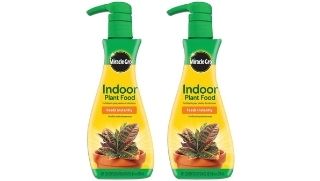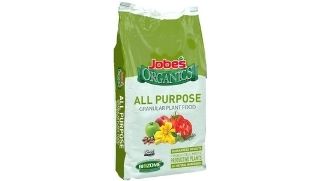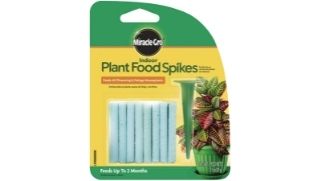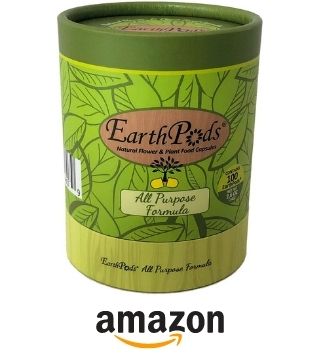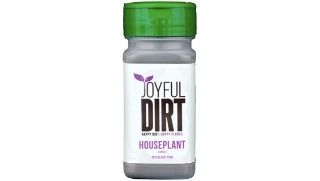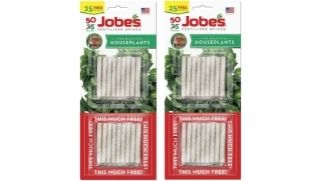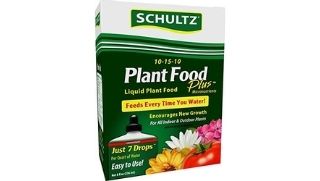Top Fertilizers for all Your [Indoor] Potted Plants
Our Picks for Busy Shoppers:
Miracle Gro Liquid Plant Food
Instantly feeds all indoor plants, including edibles. This 8 oz. liquid product from Miracle Gro is great all-around.
CHECK CURRENT PRICEJobe’s Organics 09524 Granular Fertilizer
This all-purpose 4-4-4 product from Jobe’s Organics is OMRI listed. It’s a totally natural product you can use indoors.
CHECK CURRENT PRICEMiracle Gro Indoor Plant Food Spikes
For budget and convenience, these fertilizer spikes by Miracle Gro are the top choice for sure. Lasts for 2 months!
CHECK CURRENT PRICEIndoor plants are beautiful additions to any home! 🪴 They add color, life, and a feeling of nature inside your living space. Much like your plants outside, indoor plants also need some TLC from you to really thrive. And fertilizing them is a first step towards their good health.
Table of Contents:
- Why should you fertilize your indoor plants?
- When should you fertilize your indoor plants?
- Types of Fertilizers
- Things to Consider When Fertilizing House Plants
- Top Fertilizers for Your Indoor Plants
- Miracle-Gro Indoor Plant Food (Liquid)
- Miracle-Gro Indoor Plant Food (Fertilizer Spikes)
- Jobe’s Organics 09524 Purpose Granular Fertilizer
- Joyful Dirt Organic Premium Concentrated House Plant Food and Fertilizer
- Jobe’s 5001T Houseplant Indoor Fertilizer Food Spikes
- Schultz SPF45170 Purpose Liquid Plant Food
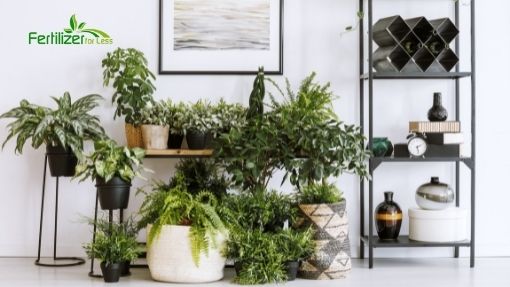
Although fertilizing indoor plants is a must, a lot of people find themselves confused on which fertilizers to use. Well, if you’re among them, you can’t be blamed as there are several types out there. Each one has different functions and ingredients, which makes it a daunting task for many first-time plant owners.
To make your life easier, here’s a guide that will teach you about the best types of fertilizers available for you. Choose from our list and ensure your indoor plants get the best fertilizer out there. We’ll take a look at different types of fertilizers and how they work, so keep reading.
Why should you fertilize your indoor plants?
Much like outdoor plants, indoor ones also need a lot of nutrients to feed on and grow well. If you just keep watering them without giving them any additional nourishment, there’s no way they can thrive in the long run. This is why regularly feeding them with fertilizers will become an inevitable part of your precious indoor garden’s maintenance.
Indoor plants that are well-fed with the right fertilizers are more likely to stay lush, green and healthy all year round. It’s important to note that fertilizers act differently from plant food. Plants are able to generate their own food through a process called photosynthesis where they combine water and carbon dioxide to produce sugar which they use to feed themselves.
Fertilizers, however, work as supplements for your plants. It provides them with essential elements called macronutrients which are Nitrogen (N), Phosphorus (P), and Potassium (K) that are usually not found in potting soil. They are referred to as macronutrients because plants need them in huge quantities. On top of these macronutrients, fertilizers also provide your indoor plants with micronutrients that improve their health and beauty. Plants both indoor and outdoor, cannot produce these nutrients on their own which is why fertilizing them is very important. As a plant owner, it’s important to remember that the food that plants produce on their own isn’t enough.
When should you fertilize your indoor plants?
When should you fertilize your indoor plants? In general, it is best to start applying fertilizer in the springtime once they have had a chance to grow some roots.
The frequency of feeding your plants with fertilizer depends on the type of indoor plants that you grow. Indoor plants that are heavy-feeders would usually need to be fertilized as often as once per week, while some may only need a monthly feeding or less. A good rule of thumb would be every two weeks during the growing season and then monthly or so during the rest of the year, until winter comes around again.
The Many Different Types of Fertilizers for House Plants
Now that we know how important fertilizers are and when your plants need them, the next step to successful indoor plant growing is to familiarize yourself with the types of fertilizers that you can use for your lovely plants. This will make choosing the right one so much easier!
When it comes to fertilizers, there are several types available on the market. The two main types of plant fertilizers are organic and inorganic options. You can pick whichever one works best according to your needs, but here’s a quick look at each type so you’ll know the pros and cons of each before choosing one for yourself.
Organic Fertilizers for Houseplants
Compost is considered an excellent fertilizer that has a myriad of nutrients and helps plants grow well by providing them with essential minerals like nitrogen, phosphate, etc., which are essential nutrients that are perfect for indoor plants at home or office spaces where regular watering may not be possible due to lack of time or because you live in a place where summers get too hot despite having access to water all year round. It also helps to improve the texture of soil and thus, can be used for both indoor as well as outdoor plants.
Organic fertilizers are derived from plants or animal matter and waste. These types of fertilizers do not contain any synthetic ingredients such as chemicals, salts, etc., Most organically rich products will provide a slow release of nutrients into the soil.
Inorganic fertilizers for Houseplants
Also known as synthetic fertilizers, are those that are manufactured artificially. Most elements and minerals found in this type of fertilizer are mined from the earth. Inorganic fertilizers are an abundant source of all three macronutrients. Additionally, they also contain:
- ammonium sulfate
- magnesium sulfate
- potassium chloride
Organic and inorganic fertilizers can come in several forms such as:
Liquid fertilizers are inorganic fertilizers that are added to the water you use when watering your indoor plants. They are simple to use and readily available. Simply dilute the appropriate amount when your plants need feeding. With liquid fertilizers, you can hold off fertilizing during the winter months.
Liquid fertilizers can be used in both hydroponic and soil-based growing techniques. They are also easy to transport and you won’t even need special storage. There is a range of liquid plant food available, each with different applications such as vegetative growth or root production.
Granular plant fertilizers, on the other hand, will have to be mixed into the soil. The nutrients they contain are released to the plants when they get water. This type is best when you are repotting a plant in fresh soil.
Slow-release fertilizers release nutrients into the soil gradually. They come in pods, spikes, and capsules. Many plant owners prefer this type of fertilizer because you don’t need to remember to feed the plants. Controlling how much nutrients get into the pot is a bit tricky, however. If you have small pot plants, then this type would generally fit your fertilization needs.
Looking for a One-and-Done Indoor Plant Food?
Well if you can’t remember to fertilize your plants, don’t sweat it because this product feeds for FIVE FLIPPING YEARS! Woo!
This is a SUPER-Slow release fertilizer spike you use once every five years! At the time of writing, you get 100 spikes for less than 40 bucks. So, if you have enough room for 50 houseplants, this one purchase will get you through the whole damn decade. Check it out on Amazon by clicking the picture on the right:
Things to Consider When Fertilizing your House Plants
Fertilizing your house plants is crucial for their healthy growth and they are generally safe but it needs to be done cautiously. It’s very important to avoid overfeeding your house plants as it can be detrimental to their growth rather than beneficial. If you notice any signs of fertilizer burn, immediately cut back on the dosage until it goes away.
Knowing your plants’ current health situation is also very important. You need to keep an eye for any signs of deficiencies or malnutrition to be able to address them properly. Some of the most common symptoms of plant nutrient deficiencies are as follows:
- Drooping leaves.
- Tiny or yellow spots on leaves.
- Stunted root growth.
- Wilting foliage and buds at the tips of branches.
- Yellowing or dull green leaves.
- Purpling coloration in stems and veins of older leaves.
- Smaller flowers and fruits than usual
Remember that plants can show these symptoms even if they are low in just one particular element! This is why regular soil testing should be done before fertilizing your indoor plants again. If you notice any of those signs, revisiting how you apply your fertilizer would be beneficial. Following the manufacturer’s guide on the proper application can do a great deal in keeping your plants lush and green all year round.
The Best Fertilizer Products for [HAPPY] Indoor Plants
When choosing the best fertilizer for your indoor plants, remember that they are different from their outdoor counterparts. For one thing, you can’t use any type of fertilizers on them because it will most likely burn or kill some types of house plants.
So what is the best fertilizer for your inside plants? The answer depends upon several factors such as:
- The amount of light and water they receive every day.
- The source of light, artificial or not.
- The species of plants you have chosen to grow in a pot indoors
- Other growing things near them like trees or grasses whose roots could leech into the soil mix eventually contaminating it with salt build-ups and making nutrients inaccessible to your plants.
The best fertilizer for house plants is a balanced nutrient solution that contains all the essential nutrients required to sustain life. Some of these include carbon, nitrogen, and potassium just to name some examples. When mixed together properly, it can help your inside plants grow better than ever!
We know you’re as excited as we are so without further adieu, we give you our top picks for your indoor plants.
Miracle-Gro Indoor Plant Food (Liquid)
First on our list is Miracle-Gro Indoor Plant Food which is a liquid fertilizer. Miracle-Gro Liquid fertilizer is great to be used on all types of indoor plants. It amazingly instantly feeds all indoor plants, including edibles. It’s also very convenient to use. Just apply the formula directly into the soil or mix it with water once a week. No special tricks are needed!
With a name like Miracle-Gro you can trust that you’re getting a consistent product that’s been tested over the years to be safe for your plants. with close to 5,400 reviews and a 4.5 star average at the time of writing, this is the #1 conventional fertilizer on our list.
PROS
- Fast acting liquid formula
- Can be mixed with water
- Affordable and perfect for 2-3 plants
CONS
- Not listed as an organic product
- More frequent feedings required
Miracle-Gro Indoor Plant Food (Fertilizer Spikes)
Our next best pick for your house plants is Miracle-Gro’s Fertilizer Spikes Indoor Plant food. It can feed all types of flowering and foliage house plants for up to 2 months. Containing all necessary micro nutrients specially formulated for house plants, it is great for continuous feeding. Be sure to follow the manufacturer’s application instructions to get optimal benefits for your lovely indoor plants.
If you’re busy like me, this may be a better fit than the liquid version. Just don’t forget to water for two whole months, and you’ll be fine! These spikes have been on the market for as long as I can remember and they literally have 50,000 reviews at the time of writing.
PROS
- No mess product that lasts 1-2 months
- Beyond affordable! 16 spikes for less than 3 bucks at time of writing
- 50,000+ reviews and 4.5 star average
CONS
- People seem to be putting spikes too close too roots and over watering
- As long as you don’t make that mistake, this is a great product!
Jobe’s Organics 09524 Purpose Granular Fertilizer
Third on the list is Jobe’s Organics All Purpose Granular Fertilizer with Biozome. This granular fertilizer is specially formulated to help your indoor plants increase their root mass and bear more fruits. Additionally, it supports healthy foliage growth.
It’s great for all your vegetables, flowers, trees, and shrubs. Mix Jobe’s Organics Granular Fertilizer to your soil prior to planting to restore, maintain, and enhance it for a healthy and lush house plant.
If you’re into organic growing, then Jobe’s Organics is a great choice!
PROS
- OMRI listed organic product
- 6,000+ reviews and a 4.5 star average at writing
- Great for mixing in before planting!
CONS
- Granular products might not be best if you’re trying to save a droopy plant
- All purpose – Check out the extensive line of specific fertilizers Jobe’s offers as well!
Joyful Dirt Organic Premium Concentrated House Plant Food and Fertilizer
Another organic option that you should seriously consider is Joyful Dirt Organic Premium Concentrated House Plant Food and Fertilizer. This fertilizer won’t only add nutrients to your soil but also increases the microbial and fungal activity in your planter. It is designed for all types of house plants, lawns, flower, vegetable, and herb gardens.
If you’re a seasoned house plant owner, then you might already know that over time, the quality of the soil diminishes. Joyful Dirt contains a full spectrum of all organic ingredients to revive soil quality, therefore, increasing the vigor of your plants.
The best part about this product is that you can adjust its strength according to how well or not so well plants are doing. It’s simple: if the plant looks pale and sickly then increase Joyful Dirt’s concentration by adding more of this organic fertilizer into the soil when watering; on the other hand, if everything seems fine just use Joyful Dirt at a regular dose or once a month. You can’t go wrong with Joyful Dirt.

QUICK GARDENING FACTS
Indoor potting soil tends to be devoid of life…fix this with a product that includes beneficial microorganisms like Joyful Dirt’s 3-1-2 product.
PROS
- An organic product that includes beneficial microorganisms
- Small size packaging, but just a sprinkle packs a punch!
CONS
- This is definitely a ‘Cadillac’ brand, but it comes at a higher price point for sure
- There really are no other cons…it’s top shelf stuff for those of you with needy plants
Jobe’s 5001T Houseplant Indoor Fertilizer Food Spikes
If you liked the convenience of the Miracle-Gro spikes, but you want a more natural product, this one’s for you!
Jobe’s Organics 50001 Houseplant Indoor Fertilizer Food Spikes are an excellent choice for people who want to take care of their plants while being on the go. These fertilizer spikes contain all three macronutrients, as well as phosphorus and calcium; Jobe’s also added in some micronutrients like magnesium, iron, and zinc that your indoor greenery may be lacking. The best part about this product is its convenience: you can use it anywhere without worrying about spillage or leakage since they don’t come with soil. You just have to open up a container of these little food pellets underwater then watch them dissolve!
If you’re a busy plant owner, Jobe’s 5001T Houseplant Indoor Fertilizer Food Spikes could be your plants’ saving grace.
PROS
- A great deal! As I write this a 100 pack costs less than 7 bucks!
- Organic slow release fertilizer for on-the-go plant owners
CONS
- Be careful not to puncture plant roots
- Also it’s best to add these near the edge of the flower pot to avoid root burn
Schultz SPF45170 Purpose Liquid Plant Food
Schultz SPF45170 Purpose Liquid Plant Food is a great option for the plant lover who wants versatility in their fertilizer. This is designed to help different types of plants grow at their best; Schultz’s SPF45170 Purpose Liquid Plant Food makes it easy to give your green friends exactly what they need! These spikes dissolve slowly in the potting soil without altering pH balance making them great for all types of house plants including cacti, bonsai trees, succulents, vegetables, and more.
It’s also very easy to use. Just mix one part of this concentrated fertilizer with five parts water (preferably at room temperature) and pour over the soil around your plants once monthly for general feeding; add every two weeks or as needed during periods of heavy growth like spring and summer months, when leaves are larger and the plant is actively growing.
PROS
- Extremely simple to use
- Steady and consistent fertilization with each watering
CONS
- Difficult to find in some retail markets
- I could see this being easy to forget for busy people
The Verdict: This Week It’s a Draw!!!
Since products mostly fell into the category of granules/liquid or spikes, we decided it would only be fair to pick a winner for both a fast release and a slow release version. If you’re a busy on-the-go person and your plants look fine right now, click the button below for Earth Pods. They last for years and don’t have any questionable ingredients. For everyone else, the image on the left is perfect when you need a potent and premium fertilizer product to revitalize soil biology.
Earth PodsChoosing the best fertilizer for your lovely house plants can be difficult and confusing. But it all boils down to your preference and how much time you have on your hands dedicated to tending your plants. In general, all fertilizers have their fair share of pros and cons but if you strictly follow the appropriate application as advised, they are sure to improve the quality and health of your indoor plants.
The bottom line is, fertilizing your indoor plants gives far more benefits than not doing it. Choose from our top picks above and fertilize wisely!
About Blake
Blake’s been managing this website since 2016. He provides editorial review of all our content, publishes our newsletter and is the person to reach out to for advertising opportunities. Info@fertilizerforless.com

